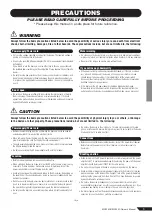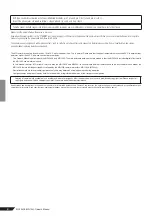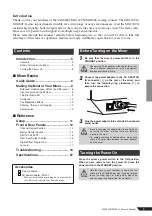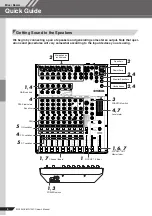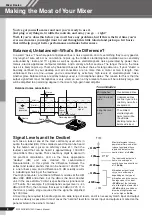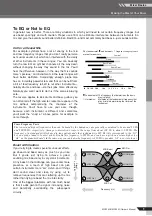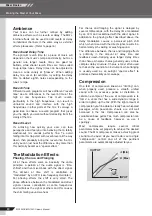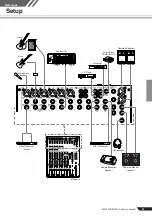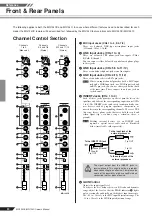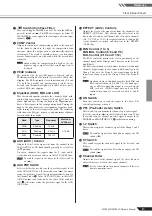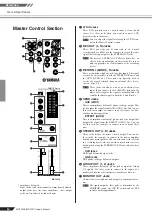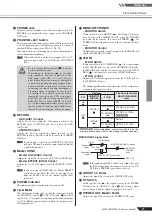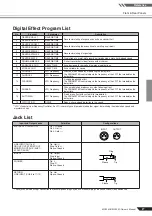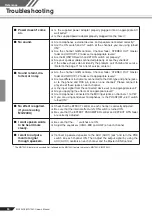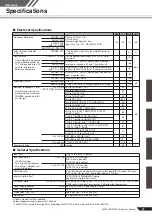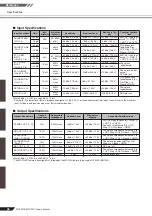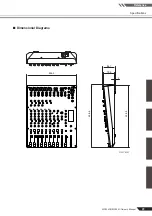
Front & Rear Panels
MG124CX/MG124C Owner’s Manual
13
Reference
7
Switch (High Pass Filter)
This switch toggles the HPF on or off. To turn the HPF on,
press the switch in (
). The HPF cuts frequencies below 80
Hz (the HPF does not apply to the line inputs of stereo input
channels
34
).
8
COMP Control
Adjusts the amount of compression applied to the channel.
As the knob is turned to the right the compression ratio
increases while the output gain is automatically adjusted
accordingly. The result is smoother, more even dynamics
because louder signals are attenuated while the overall level
is boosted.
Avoid setting the compression too high, as the the
higher average output level that results may lead to
feedback.
9
PEAK Indicator
The peak level of the post-EQ signal is detected, and the
PEAK indicator lights red when the level reaches 3 dB below
clipping. For XLR-equipped stereo input channels (5/6 and
7/8), both the post-EQ and post-mic-amp peak levels are
detected, and the indicator lights red if either of these levels
reaches 3 dB below clipping.
0
Equalizer (HIGH, MID, and LOW)
This three-band equalizer adjusts the channel’s high, mid,
and low frequency bands. Channels 9/10 and 11/12 have two
bands: high and low. Setting the knob to the
t
position pro-
duces a flat response in the corresponding band. Turning the
knob to the right boosts the corresponding frequency band,
while turning to the left attenuates the band. The following
table shows the EQ type, frequency, and maximum cut/boost
for each of the three bands.
A
AUX (AUX1) Control
Adjusts the level of the signal sent from the channel to the
AUX (AUX1) bus. The knob should generally be set close to
the
t
position.
On stereo channels, the signals from the L (odd) and R
(even) channels are mixed and sent to the AUX (AUX1) bus.
To send the signal to the buses set the ON switch to
on (
).
B
AUX PRE Switch
Selects whether the pre-fader or the post-fader signal is fed
to the AUX (AUX1) bus. If the switch is on (
), the mixer
sends the pre-fader signal (the signal immediately prior to
the Channel fader
I
) to the AUX (AUX1) bus, so that AUX
(AUX1) output is not affected by the fader. If the switch is
off (
) the mixer sends the post-fader signal to the AUX
(AUX1) bus.
C
EFFECT (AUX2) Controls
Adjusts the level of the signal sent from the channel to the
EFFECT (AUX2) bus. Note that the signal level sent to the
bus is also affected by the Channel fader. On stereo channels
(5/6, 7/8, 9/10, or 11/12), the signals from the L (odd) and R
(even) channels are mixed and then sent to the EFFECT
(AUX2) bus.
D
PAN Control (1 to 4)
PAN/BAL Control (5/6 and 7/8)
BAL Control (9/10 and 11/12)
The PAN control determines the stereo positioning of the
channel signal on the Group 1 and 2 buses or on the Stereo L
and R buses.
The BAL control knob sets the balance between left and right
channels. Signals input to the L input (odd channel) go to the
Group 1 bus or to the Stereo L bus; signals input to the R
input (even channel) go to the Group 2 bus or the Stereo R
bus.
On channels where this knob provides both PAN and
BAL control (channels 5/6 and 7/8), the knob oper-
ates as a PAN control when input is received via the
MIC jack or L (MONO) input only, and as a BAL
control when input is received via both L and R
inputs.
E
ON Switch
Turn this switch on to send the signal to the buses. The
switch lights orange when on.
F
PFL (Pre-Fader Listen) Switch
This switch lets you monitor the channel’s pre-fader signal.
Press the switch in (
) so that it lights to turn it on. When
the switch is on the channel pre-fader signal is output to the
PHONES and MONITOR OUT
I
jacks for monitoring.
G
1-2 Switch
This switch assigns the channel’s signal to the Group 1 and 2
buses.
To send the signal to the Group buses engage the ON
switch (
).
H
ST Switch
This switch assigns the channel’s signal to the Stereo L and
R buses.
To send the signal to the Stereo buses engage the ON
switch (
).
I
Channel Fader
Adjusts the level of the channel signal. Use these faders to
adjust the balance between the various channels.
Set the fader sliders for unused channels all the way
down to minimize noise.
Band
Type
Frequency
Maximum
Cut/Boost
HIGH
Shelving
10 kHz
±
15 dB
MID
Peaking
2.5 kHz
LOW
Shelving
100 Hz
NOTE
NOTE
NOTE
NOTE
NOTE
NOTE



